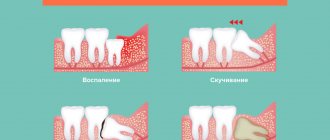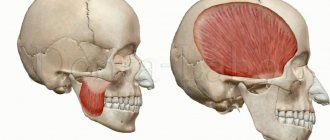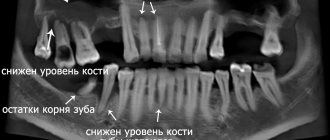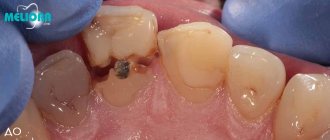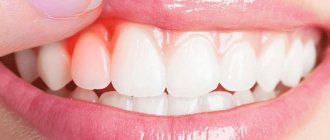In 6-10 year old children, baby teeth often fall out - a harbinger of the appearance of permanent teeth in their place. This fact should not cause any particular concern. However, there are cases when real teeth begin to loosen on their own. This is a signal that you need to consult a doctor without wasting time before the child’s health condition becomes dangerous. Loosening of baby teeth is a sure sign of a malfunction in the immune system.
Loosening of permanent teeth is a sign of both emerging diseases in the oral cavity and sudden problems with internal organs. The most common manifestations are:
- Periodontitis;
- Inflammation of the gums;
- Caries;
- Generalized metabolic disorders;
- Injuries.
If you find that your child has one or more molars that are loose, contact your dentist immediately. In some cases, the tooth root may become loose due to not entirely successful heredity - the root of the new tooth does not grow well into the jaw. It is necessary to check whether the parents of this child had such cases.
Periodontitis
This disease manifests itself at the age of 9 years - on average in 4% of children. When it occurs, the tissues surrounding the tooth become inflamed, and it begins to wobble. The basis of this process is the loss of properties. Inherent in tissues that have not yet fully matured. Here lies the main reason why teeth become loose and fall out.
To exclude such an unfavorable scenario, timely and proper teeth cleaning is needed. In childhood and adolescence, increased load on the same teeth (on the one hand), or the absence of products elastic enough for chewing, which allow, like a kind of simulator, to train growing teeth, is unacceptable. After all, what is trained during growth is what develops comprehensively.
Caries
Caries in childhood and adolescence develops much more rapidly than in adults. With it, the enamel is rapidly affected first, then the carious cavity penetrates the dentin and reaches the pulp. The last stage can lead to pulpitis and the need for drilling of the dental canal. The tooth enamel itself in children is immature - it is the most vulnerable, that is, it does not resist caries damage as actively as it does in adults. The maturation of tooth enamel continues for up to several years; it is necessary to brush your teeth twice a day, as doctors advise, in order to prevent the parasitic process.
Caries also manifests itself from the inside or from below - it is not the enamel of the crown or even the neck of the tooth that is affected, but the root, or the underlying structures begin to collapse. You can guess this by the fact that the tooth suddenly began to loosen.
When a child’s tooth hurts and is loose: what to do
Pain is evidence that some processes in the child’s body are disrupted. Even when it comes to such a simple thing as a change in bite, pain should not be ignored. A dental consultation is indicated in the following cases:
- During an early shift. Renewal of the bite begins at 5-6 years old, but what to do when a baby tooth in a 3-4 year old child is loose. Early change of dental units can lead to deformation of the dentition and abnormal development of the bite. A baby’s swaying tooth is a reason to see a doctor. In this case, the orthodontist will save space for the new unit, and the child’s adult bite will form normally.
- Prolonged period of loss of baby teeth. When a tooth is completely crooked, it hurts, but does not fall out, the doctor must definitely examine the child. The reasons for the delay can be very different - from improperly absorbed roots to gum disease.
- Deterioration in the general well-being of the young patient. Fever, weakness and nausea are signs of inflammation. The doctor will determine the cause of the problem and suggest the right solution.
- Change in mobility. When the front baby tooth of a 5-year-old child becomes loose, and then stops, it’s a reason to examine the gums. Redness, swelling and pain are possible causes of inflammation of the gums and periodontal tissues.
During the consultation, the doctor will examine the condition of the child’s oral cavity and select the optimal treatment. This may include preservation of the tooth, removal under sedation, and recommendations for care to alleviate the condition.
Plaksina Margarita
Sedation in dentistry is a modern, comfortable anesthesia. The child is put into a half-sleep and asked to breathe “laughing” gas through a mask. The mixture supplied - nitrous oxide and oxygen - has a relaxing effect: it relieves anxiety, panic, but leaves consciousness. The baby understands everything, but is not afraid at all. This allows you to carefully remove a loose tooth without any discomfort.
General diseases of the body
Children's teeth can also become loose due to systemic diseases. They are most often based on a violation of the blood flow of individual tissues adjacent to the teeth, or metabolic disorders. These include psoriasis, diabetes mellitus and diabetes insipidus, thyroid pathologies, congenital connective tissue disorders and several other diseases.
All these destabilizing factors lead to obstruction of blood flow through the capillaries in the body. The gums and pulp in the tooth are rich in microcapillaries, through which blood delivers oxygen and nutrients to the teeth, and removes waste products and excess carbon dioxide. If these processes are untimely, degenerative phenomena occur in which tissues starve, as a result, their growth and renewal stop, and their accelerated wear and degradation occurs. This causes the weakened tooth (or several teeth) to wobble and may fall out.
Causes
The mobility of permanent teeth in a child is an alarming sign and indicates both diseases in the oral cavity and possible problems with internal organs.
The most common causes of loose molars can be:
- periodontitis;
- inflammatory gum diseases;
- caries;
- systemic diseases and metabolic disorders;
- injuries.
Hereditary predisposition also plays a certain role in the development of this pathology, as a result of which the tooth root is poorly fixed in the tissues of the jaw. This reason may be supported by cases of detection of early tooth loss in one family among close relatives.
Let's look at each of the reasons in more detail.
Periodontitis
Periodontitis most often occurs between the ages of 9 and 10 years. And although this disease occurs in only 3-5% of children, it is the main cause of pathological loosening of teeth in childhood. The peculiarity of this pathology is that it affects functionally immature tissues, which can quickly lead to tooth loss.
Most often, periodontitis occurs due to poor oral hygiene and the accumulation of plaque and food debris on the teeth, which become a breeding ground for bacteria. Also, inflammation of periodontal tissue can occur if there is a habit of biting food on only one side or with a lack of dense foods in the child’s diet, as a result of which the teeth do not receive the necessary chewing load.
Inflammatory gum diseases
The most common pathology is gingivitis, which appears if dental plaque is not completely removed during brushing, when the body’s immune defense is weakened, after infectious diseases, or when the child’s diet lacks essential vitamins and minerals. A characteristic sign of inflammation in the gums is their bleeding while brushing your teeth or eating. Without treatment, gingivitis is often complicated by loosening of teeth and subsequent loss of teeth.
Caries
In children, caries is characterized by a high rate of development and deep tissue damage, even with a small visible defect. Since after eruption, the child’s molars do not have mature enamel, and the process of its formation still continues for several years, it is during this period that the most dangerous period is for the development of carious cavities.
Sometimes forms of caries occur in which the invisible part of the tooth is affected. And they are discovered only after the tooth begins to wobble.
General diseases of the body
Systemic diseases accompanied by impaired blood supply to tissues and metabolic pathologies can also lead to loose teeth in children and adolescents.
Such diseases include:
- psoriasis;
- diabetes;
- thyroid diseases;
- hereditary pathology of connective tissue.
With this pathology, blood microcirculation in the periodontium is disrupted, as a result of which the tissues do not receive the required amount of nutrients and oxygen. Dystrophic processes begin, which lead to a weakening of the connection with dental tissues - the child’s tooth begins to wobble.
Injuries
Children are characterized by great mobility, due to which injuries and falls often occur. At the same time, the immaturity of dental tissue makes it very fragile and brittle. It is not uncommon for a child to hit his face during a fall and knock out his front tooth. Also, after an impact, breaks and fractures of the teeth may occur, which will be manifested by their pathological mobility.
Sometimes the habit of chewing hard objects or grinding their teeth can lead to dental injury in children.
Injuries
Many children find it impossible to sit still. And some of them sometimes fall. If the injury occurs in the vicinity of the jaws, the teeth may also suffer. There are often cases where a child knocked out one or even two or three teeth during a fall. But tooth fractures are not always open - cracks and root fractures can also occur - the tooth tilts to the side, and accordingly, it immediately begins to wobble.
Dental injuries also appear when a child suffers from bruxism (grinding his teeth in his sleep), or tried to chew, for example, a candy that was too hard, or, for example, got a stone in the cereal from which the porridge was cooked.
What to do in such a situation: treatment methods
Many parents are concerned about the question: “What to do if a child’s permanent tooth begins to loosen?” The answer to it directly depends on the reasons that led to such an unpleasant and frightening symptom. The first thing you need to do is see a dentist. If you put off visiting a specialist for too long, you may lose your tooth altogether.
Firstly, if the cause of the problem is gingivitis or periodontitis, you will have to undergo professional cleaning to remove plaque and hardened deposits. After this, the doctor will prescribe anti-inflammatory therapy, and in advanced cases, splinting may be required - securing the position of the teeth by fixing the splint on the back side of the row.
In some cases, splinting can save teeth
Secondly, if mobility is the result of an injury, then each situation will be considered individually.
“Someone pushed my daughter at school and she hit her head on the desk. The result is a fractured front tooth! As the doctor said, it’s good that there is no root fracture. Fortunately, we managed to get to the dentist, and he fixed everything. True, the enamel has noticeably darkened, and it is not yet possible to bleach it. We’ll have to wait until my daughter turns 18, and then we can get veneers.”
Evgenia O.S., Izhevsk, from correspondence on a thematic forum
Read more about methods of treating dental injuries in our special article >>>
Thirdly, if caries or pulpitis is to blame, then first a specialist assesses the situation and decides if there is still a chance to save the tooth. Removal is resorted to only in the most extreme cases. If it is still possible to carry out full treatment, then the cavity inside the tooth is thoroughly cleaned of anesthetized tissue, and then filled.
Fourthly, if the cause lies much deeper and is associated with systemic diseases of internal organs, then a pediatrician, endocrinologist and other relevant specialists will also participate in the treatment.
Treatment
When a child complains of looseness and pain in one or more molars, urgently visit the dentist with him. It is the dentist who will decide whether it is possible for a child not to lose a loose tooth. The doctor will take a number of measures to save the problematic tooth, which will avoid its loss and unpleasant consequences in the future. Of course, the tooth can later be replaced “from scratch” (along with a pin) - but it is better to try to preserve the original one.
When the cause of tooth loss is periodontitis or gingivitis, it is necessary to urgently clean the teeth of plaque, as well as prevent the development of inflammation that has already begun. It is possible that the teeth are splinted - this will stop their ongoing loosening.
In the event of a tooth injury, the question is raised about the possibility of saving it. When the damage is small, it is possible to preserve all intact dental tissues - they will help facilitate the process of prosthetics, becoming the “foundation” for a renewed tooth. If caries has developed, after a thorough examination, an attempt is made to save the molar. When the damage is too great, the tooth is simply removed to prevent it from rotting and damage to internal organs due to infection in the blood. If the carious cavity is small, the tooth is filled - nerves and blood vessels are removed from the pulp, disinfected with medications, and then dental cement is injected - an adhesive base that, after hardening, resembles hard dental tissue; In turn, a seal is installed on it.
If no visible damage to the teeth is found, the child undergoes a comprehensive medical examination. If any diseases are detected, he undergoes timely treatment.
A permanent tooth is loose - what to do if we are talking about a child
If a child’s tooth begins to wobble at the age of 6, this can only mean one thing – a permanent one is on the way. There is no point in worrying about this. But what really requires attention is the appearance of mobility of a permanent tooth without clearly defined reasons. Such a symptom may indicate either an advanced form of dental pathology or a serious disease of internal organs. From this article you will learn what to do when a child’s permanent molar is loose and why this can happen.
Why might a permanent tooth become loose?
On a note! First, we need to make some clarifications on the terminology. When it comes to permanent teeth, you can often hear that they are simply called molars. This is not entirely true, since the first milky elements of the series also have their own root system.
Prevention
Taking care of your teeth is preserving the attractiveness of your smile, which is the calling card of both a child and, subsequently, an adult who sets important goals for himself. This means that taking care of your teeth should be timely, and it is better to get used to this right away in childhood. Parents will ensure that the child carries out high-quality sanitation of the oral cavity and teeth every day, and twice a year he needs to visit the dentist. Equally important is a balanced diet. If problems do affect at least one tooth, do not ignore them: you are responsible for the health of your child.
To pull out or not
Units are removed according to indications. They can be absolute and relative.
- Severe carious destruction, when the tooth has darkened, therapy is impossible.
- The eruption of the root organs precedes the loss of mammary units. In such a situation, the tooth needs to be pulled out.
- Multiple severe fistulas on the gingival tissues.
- Large root cysts.
- Pulpitis in severe form.
- Periodontitis, other dental diseases.
If a loose chewing organ does not fall out on its own and causes discomfort to the baby, it is usually removed, as it can lead to gum inflammation. Anesthesia is not used in this situation. Some babies push their teeth out with their tongue. Such units come off when biting into hard foods. For minor bleeding, apply a cotton swab, which must be moistened with a disinfectant. You should remove a baby tooth that is hanging by a thread so that it does not fall out at night or block your breathing.
- First you need to cool the gum with a piece of ice.
- Then you need to grab the unit with a paper napkin and quickly turn it around its axis.
- A sterile gauze pad should be applied to the wound site; a clean handkerchief will do.
Pulling out a baby tooth is not difficult. After the procedure, it is useful to rinse your mouth with chamomile decoction. It's a different matter when the little one cries and does not agree to open his mouth. You should not scold the child at the same time. You need to see a dentist. The doctor will help if:
- The root unit grows until the mammary organ prolapses; there is a fear that it will be crooked;
- Temporary incisors and molars fell out early;
- Many people in the family wore braces;
- The temperature has increased and lasts for 2-3 days;
- The tooth is loose, making it difficult to chew;
- The unit is broken, it hurts the tongue;
- Severe carious lesions;
- Diagnosed with periodontal disease or rickets, diabetes mellitus or anemia.
It happens that the chewing organs become loose, but do not fall out on their own. Most likely, there is excess calcium in the baby’s body. The quality of life of children depends on how quickly parents react.




